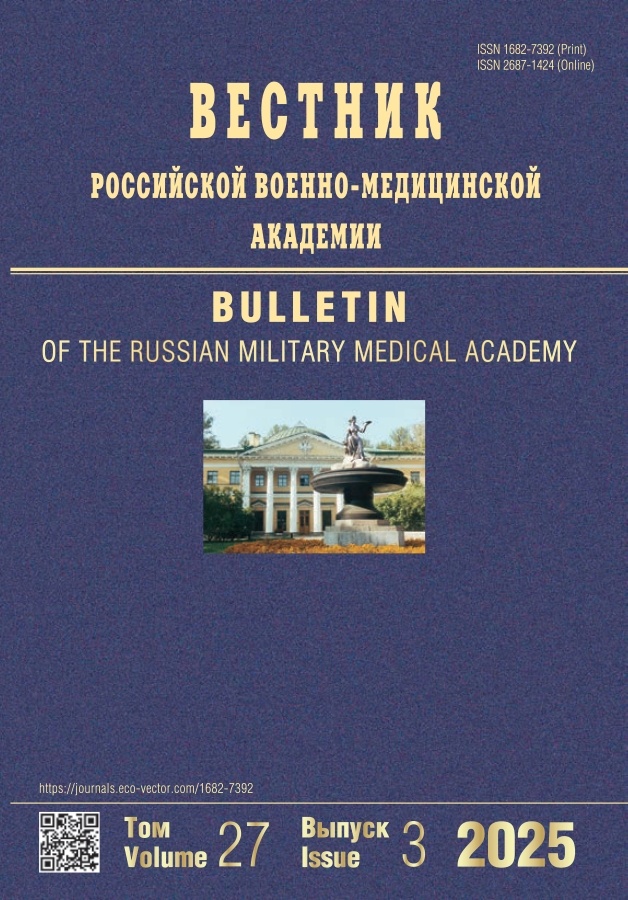Probabilistic predictive mathematical model of chronic respiratory conditions to reduce the risk of disability in case of poisoning with substances with a pulmonotoxic effect.
- 作者: Vengerovich NG1, Yudin MA1, Konshakov Y.O2, Chepur SV1, Ivanov IM1
-
隶属关系:
- Государственный научно-исследовательский испытательный институт военной медицины МО РФ
- 1602-й Военный клинический госпиталь
- 期: 卷 21, 编号 3 (2019)
- 页面: 23-29
- 栏目: Articles
- URL: https://journals.rcsi.science/1682-7392/article/view/20665
- DOI: https://doi.org/10.17816/brmma20665
- ID: 20665
如何引用文章
全文:
详细
作者简介
N Vengerovich
Государственный научно-исследовательский испытательный институт военной медицины МО РФдоктор медицинских наук, капитан медицинской службы Санкт-Петербург
M Yudin
Государственный научно-исследовательский испытательный институт военной медицины МО РФ
Email: gniiivm_15@mil.ru
доктор медицинских наук, доцент, подполковник медицинской службы Санкт-Петербург
Yu Konshakov
1602-й Военный клинический госпиталькапитан медицинской службы г. Ростов-на-Дону
S Chepur
Государственный научно-исследовательский испытательный институт военной медицины МО РФ
Email: svch@mail.ru
профессор, полковник медицинской службы Санкт-Петербург
I Ivanov
Государственный научно-исследовательский испытательный институт военной медицины МО РФкандидат медицинских наук, майор медицинской службы Санкт-Петербург
参考
- Акимов А.Г., Гайдук С.В., Халимов Ю.Ш. и др. Медицинские последствия химических аварий и катастроф, сопровождающихся выбросом хлора и аммиака // Материалы 3-го Азиатско-Тихоокеанского конгресса по военной медицине. - 2016. - С. 98-99.
- Башарин В.А., Гребенюк А.Н., Маркизова Н.Ф. и др. Химические вещества как поражающий фактор пожаров // Воен.-мед. журн. - 2015. - Т. 336, № 1. - С. 22-28.
- Медицинская токсикология. Национальное руководство / Под ред. Е.А.Лужникова // ГЭОТАР-Медиа. - 2014. - 928 с.
- Методические рекомендации по терапии дыхательной недостаточности у пораженных отравляющими и высокотоксичными веществами на этапах медицинской эвакуации: Метод. реком. утв. нач. ГВМУ МО РФ. - М., 2016. - 55 с.
- Аrmaments disarmament and international security SIPRI Yearbook // Stockholm International Peace Research Institute. - 2018. - 584 p.
- Lee J.J., Miller J.A., Basu S. et al. Building predictive in vitro pulmonary toxicity assays using high-throughput imaging and artificial intelligence // Archives of Toxicology. - 2018. - Vol. 92, N 6. - P. 2055-2075.
- Nadjafi M., Hamzeh S. Knowledge and Attitude of Iranian Red Crescent Society Volunteers in Dealing with Chemical Attacks // Bulletin of Emergency And Trauma. - 2017. - Vol. 5, N 2. - P. 122-128.
- Rea L., Parker R. Designing and conducting research (4th Edition). - San Francisco: Jossey-Bass. - 2014. - 360 p.
- The SAGE Encyclopedia of War: Social Science Perspectives. - Tufts University, USA. - 2017. - 2104 p.
补充文件







